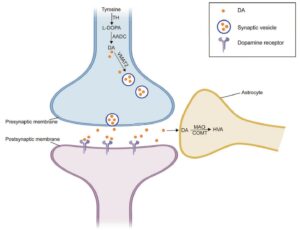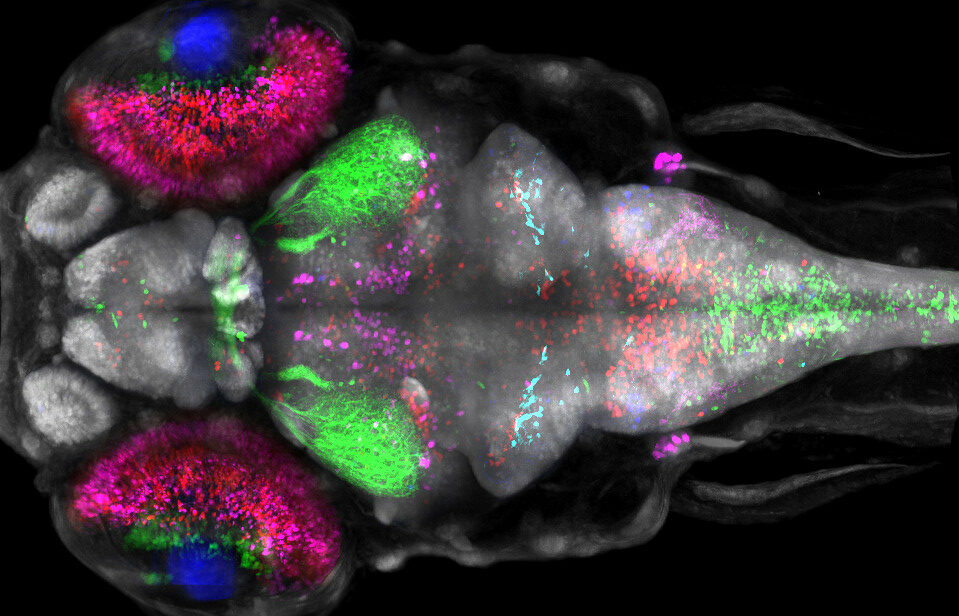April is Parkinson disease awareness month and for this reason, we decided to talk about zebrafish and this neurodegenerative disease. By their numerous advantages as a model organism, zebrafish show us one more time that they are relevant in neurotoxicity studies and neurodegenerative disorders. The prevalence of Parkinson disease has increased over the past 25 years (1) and for this reason, studies about the comprehension of this disease are really important to find an effective treatment.
Parkinson disease
Parkinson disease (PD) is the most common neurodegenerative movement disorder (2–4). The progressive loss of dopaminergic neurons in some parts of the brain are relevant to PD (2–5). There is currently no treatment that can stop the loss of neurons. The treatments used for Parkinson’s patients only help to reduce symptoms and improve the quality of life of those affected by this degenerative disease (4).

PD mainly symptoms include slowness in movements, freezing phenomenon, rigidity and tremor (7,8). But there are also non-motor symptoms such as gastrointestinal symptoms, disturbance of sleep, blood pression variations, sexual dysfunction, psychiatric symptoms, dementia and genitourinary symptoms (4,8).
Actually, PD is incurable. Treatments only improve the quality of life by reducing symptoms. They are based on the replacement of dopamine and include Levodopa, Dopamine agonists, Monoamine oxidase B (MAO-B) inhibitors, Safinamide and deep brain stimulation (4).
Levodopa is the most used molecule and the most effective drug for motor symptoms. Levodopa is able to cross the blood brain barrier and is converted to dopamine (4).
Dopamine agonists are molecules that directly stimulate the dopamine receptor by mimicking the presence of dopamine (4).
MAO-B inhibitors and Safinamide are molecules interacting with the MAO-B that have the role of degrading the dopamine. The principle of these treatments is to prolong dopaminergic stimulation. They are used in the early form of PD (4).
Deep brain stimulation is a surgical procedure that consists in placing electrodes directly in the brain. This technique is based on an electrical current delivered by electrodes to regulate and control motor symptoms (4).
As there is no curative treatment, PD can lead to death. Mortality is caused by pneumonia, cerebrovascular and cardiovascular diseases. Pneumonia is explained by the fact that PD affects the ability to coordinate between swallowing and breathing process so substances that normally would go to the stomach end up in the lungs and cause infections (1).
PD exists under sporadic forms or under familial forms (2). It is a multifactorial disease with genetics and environmental implications (7). For the genetic part, some genes have been identified as mutated in PD. Some of these genes are related to synaptic transmission, regulation processes and oxidative responses.
Concerning environmental factors, it has been shown that certain pesticides such as rotenone and paraquat and a synthetic heroin contaminant called MPTP (1-methyl-4-phenyl-1,2,3,6-tetrahydropyridine) are linked to a higher risk of PD (1,2,4,5). MPTP induces dopamine neuron loss and symptoms similar to PD (2,7). This neurotoxin is able to access quickly to the brain by passing the blood brain barrier (2). Paraquat induces oxidative stress and cytotoxicity in neurons, which leads to the dopaminergic neuron degradation (7). Rotenone induces a decrease in dopamine levels (7).
Zebrafish models of Parkinson's disease
Zebrafish are excellent in vivo models for neurotoxicity and neurodegenerative diseases. In fact, the brain and the central nervous system development occurs 3 days post-fertilization and they have, as humans, a blood brain barrier (9). Their nervous system is very well-characterized and zebrafish possess similar cognitive processes with humans such as learning, memory and anxiety (1). Another major advantage for this kind of studies is that chemical solutions and compounds in water can penetrate directly in the fishes (4,9). As a reminder, zebrafish and humans share a high genetic, morphological and physiological homology for approximately 82% of disease genes (3,5,9).
In Parkinson disease (PD) study, zebrafish are mainly used to test environmental compounds, to understand the genetic part of this disease and to test different treatments. There exist two major ways to obtain zebrafish with PD. It is possible to have a neurotoxin-induced model and transgenic model (1).
To induce PD in zebrafish, neurotoxins used are MPTP, rotenone, paraquat and 6-OHDA (6-hydroxydopamine) (1). MPTP is the most common neurotoxin used because it easily crosses the blood brain barrier. Concerning 6-OHDA which is a molecule used to induce PD symptoms in animal models, it is non permeable to the blood brain barrier so the administration is done by injection directly in the target brain region (1).

Transgenic models are zebrafish with targeted mutated genes to mimic PD in humans (1). Knockout of these genes can be obtained by using the CRISPR/Cas9 system or the morpholino-oligos (3,7).
In biology, a knockout is a total gene inactivation in order to study the effects of the gene. In research, making knockout allows biologists to visualize in which pathways the gene is involved (10).
If you want to learn what CRISPR/Cas9 is, you can always read our article about this system in zebrafish: Precise spatiotemporal genome editing in Zebrafish using CRISPR/Cas9. Information about morpholino-oligos used to knockout genes are available in one of our articles : Fifth in the series: Prof. Janet Heasmann.
Transgenic zebrafish can also have markers to follow in direct the expression of certain genes or proteins (as shown in the first image) (9).
Zebrafish are really useful in PD studies because they allow the study of different environmental chemical compounds on brain development and of different neurotoxicity pathways. This is a very important point to test the effects of pesticides on organisms in contact with them and therefore to detect risks for human health (9).
Conclusion
Zebrafish is a great model to study Parkinson’s disease because of its numerous advantages, such as the high level of homology with humans, a well-characterized nervous system and the similarities in cognitive processes. For these reasons, zebrafish can also be useful to study other neurodegenerative diseases such as Alzheimer and Huntington’s disease.
References
- Razali K, Othman N, Mohd Nasir MH, Doolaanea AA, Kumar J, Ibrahim WN, et al. The Promise of the Zebrafish Model for Parkinson’s Disease: Today’s Science and Tomorrow’s Treatment. Front Genet. 2021 Apr 15;12:655550.
- Bretaud S, Lee S, Guo S. Sensitivity of zebrafish to environmental toxins implicated in Parkinson’s disease. Neurotoxicol Teratol. 2004 Nov;26(6):857–64.
- Soman SK, Bazała M, Keatinge M, Bandmann O, Kuznicki J. Restriction of mitochondrial calcium overload by mcu inactivation renders neuroprotective effect in Zebrafish models of Parkinson’s disease. Biol Open. 2019 Jan 1;bio.044347.
- Balestrino R, Schapira A h. v. Parkinson disease. Eur J Neurol. 2020;27(1):27–42.
- Makhija DT, Jagtap AG. Studies on sensitivity of zebrafish as a model organism for Parkinson’s disease: Comparison with rat model. J Pharmacol Pharmacother. 2014 Mar 1;5(1):39–46.
- Xu H, Yang F. The interplay of dopamine metabolism abnormalities and mitochondrial defects in the pathogenesis of schizophrenia. Transl Psychiatry. 2022 Nov 7;12(1):464.
- Vaz RL, Outeiro TF, Ferreira JJ. Zebrafish as an Animal Model for Drug Discovery in Parkinson’s Disease and Other Movement Disorders: A Systematic Review. Front Neurol. 2018 Jun 1;9:347.
- Schultz W. Multiple Dopamine Functions at Different Time Courses. Annu Rev Neurosci. 2007;30(1):259–88.
- d’Amora M, Giordani S. The Utility of Zebrafish as a Model for Screening Developmental Neurotoxicity. Front Neurosci. 2018 Dec 18;12:976.
- Fifth In The Series : Prof. Janet Heasman – Bionomous [Internet]. [cited 2023 Apr 19]. Available from: https://bionomous.ch/articles/fifth-in-the-series-janet-heasman/
First image : G. Marquart, H. Burgess, National institute of Child Health and Human Development, National Institutes of Health



